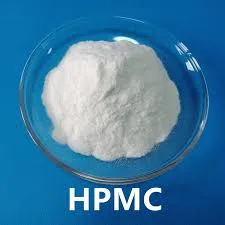
Xul . 25, 2024 04:31 Back to list
Exploring the Applications and Benefits of Hydroxypropyl Methyl Cellulose in Various Industries
Hydroxypropyl Methyl Cellulose An Overview
Hydroxypropyl Methyl Cellulose (HPMC) is a versatile and widely used cellulose derivative in various industries, including pharmaceuticals, food, cosmetics, and construction. It plays a critical role due to its unique properties, which include excellent thickening, emulsifying, and film-forming capabilities. This article provides an overview of HPMC, its applications, benefits, and safety considerations.
Chemical Composition and Properties
HPMC is synthesized from cellulose, a natural polymer derived from plant sources. By modifying cellulose with hydroxypropyl and methyl groups, HPMC comes to exhibit properties that are distinct from its parent compound. The degree of substitution of hydroxypropyl and methyl groups influences its solubility, viscosity, and thermal stability. Generally, HPMC is available in various grades, which differ in their viscosity and solubility levels, allowing for tailored applications across diverse sectors.
One of the most notable characteristics of HPMC is its ability to dissolve in water and form a gel-like structure upon heating. This reversible gelation makes it an ideal thickening agent in many formulations. Moreover, HPMC is stable across a broad range of pH levels and temperatures, making it suitable for various harsh environments.
Applications in Pharmaceuticals
In the pharmaceutical industry, HPMC is a vital ingredient in the formulation of controlled-release drug delivery systems. Its ability to form gels allows for the controlled release of active pharmaceutical ingredients (APIs), enhancing therapeutic effectiveness and minimizing side effects. Additionally, HPMC is used as a binder in tablet formulations, offering excellent compressibility and stability.
Furthermore, its film-forming properties are beneficial for coating tablets and capsules, providing a protective barrier that enhances the shelf life and stability of the medication. HPMC is also utilized as a suspending agent in liquid formulations, ensuring that solid particles remain evenly distributed.
Applications in Food and Cosmetics
hydroxypropyl methyl cellulose cas

HPMC is often used in the food industry as a food additive, where it serves as a thickener, emulsifier, and stabilizer. Its ability to improve texture and mouthfeel makes it a popular choice in products such as sauces, dressings, and low-fat food items. HPMC also finds application in gluten-free baking, providing structure and moisture retention.
In the cosmetics sector, HPMC acts as a thickening agent in creams, lotions, and other personal care products. Its ability to retain moisture makes it an attractive ingredient in hydrating formulations, enhancing the skin's overall appearance and texture.
Applications in Construction
In construction, HPMC is used as a crucial additive in cement-based products. It enhances the workability, water retention, and adhesion of mortar and plaster mixes, leading to improved performance and longevity of building materials. Its film-forming properties also contribute to the development of water-resistant coatings.
Safety and Regulations
HPMC is generally regarded as safe (GRAS) when used as an additive in food and pharmaceutical products. It is non-toxic, non-irritating, and does not exhibit harmful effects upon ingestion or topical application. Regulatory bodies, including the FDA and European Food Safety Authority (EFSA), have established guidelines for HPMC usage across various applications.
Conclusion
In summary, Hydroxypropyl Methyl Cellulose (HPMC) is a multifunctional polymer with extensive applications across several industries. Its unique properties make it an indispensable ingredient in pharmaceuticals, food products, cosmetics, and construction materials. As the demand for natural and safe additives continues to rise, HPMC stands out as a reliable choice for manufacturers seeking to enhance the efficacy and quality of their products. With its versatility and safety profile, HPMC is poised to maintain its relevance in an array of applications for years to come.
-
Unlocking the Benefits of HPMC Products: A Gateway to Versatile Applications
NewsAug.07,2025
-
Unleashing the Potential of HPMC Ashland: A Comprehensive Look
NewsAug.07,2025
-
Tile Bonding Cellulose: The Key to Superior Adhesion and Durability
NewsAug.07,2025
-
Hydroxypropyl Methylcellulose Powder: The Versatile Component in Modern Pharmaceuticals
NewsAug.07,2025
-
Hydroxyethyl Cellulose: The Versatile Solution for Various Industries
NewsAug.07,2025
-
Hydroxyethyl Cellulose (HEC): The Versatile Polymer for Various Applications
NewsAug.07,2025







